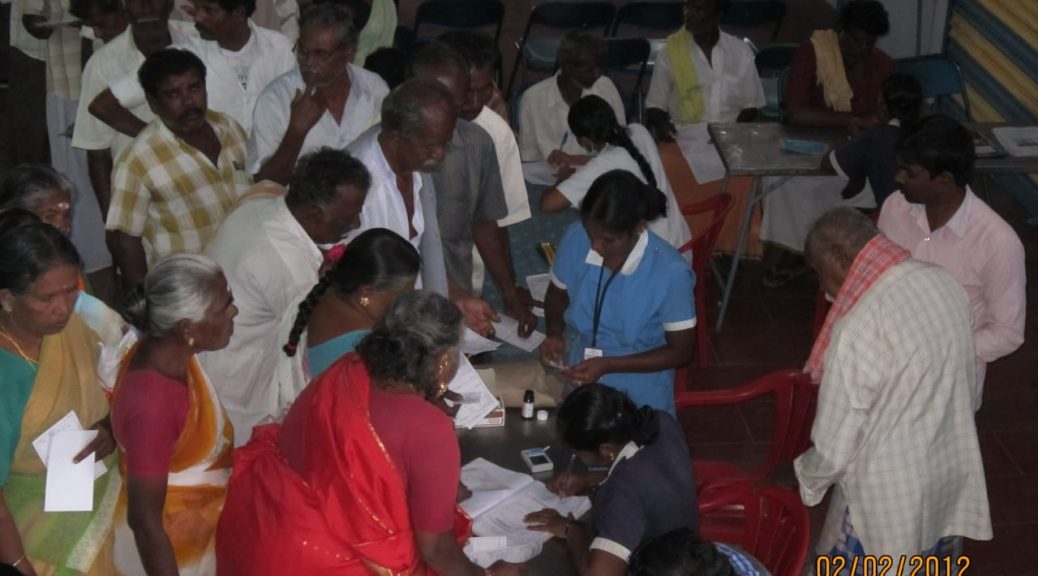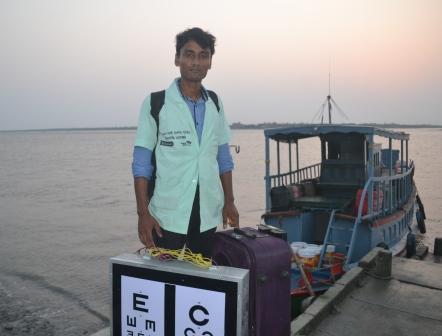Webinar of Cost Management in Outreach
Sustainability of outreach activities is a challenge for most eye care providers. Involving the local community helps bring down the cost of outreach in terms of community based logistics and increases the productivity of camps in terms of outpatients registration and cataract admissions. Successful camps increase the efficiency of the staff and attract more sponsors.
Keeping the importance of such a vital topic in view, VISION 2020 INDIA held a webinar on Cost Management in Outreach on 18 January 2019. The hour long webinar was part of the Knowledge Hub activity. Mr R Meenakshi Sundaram, Senior Manager – Outreach – Aravind Eye Hospital was the resource person. The webinar was in collaboration with Cybersight/ Orbis. Check https://local.checkintocash.com/ok/tulsa.html
Mr R Meenakshi Sundaram focussed on three vital elements for the topic: Purpose, Process and Result.
Read Report
Report on Optical Dispensing Training
With the rapid trend changes in eye-wear technology and an ageing population, well-trained optical dispensers are needed to meet the demands of this growing & demanding sector. There is a need to develop the skills to interpret prescriptions, provide advice to clients about spectacle frames, lenses, contact lenses, sunglasses and safety eye-wear.
To meet the need of this 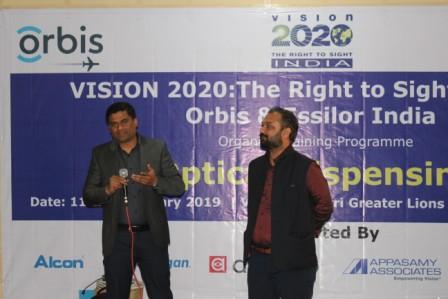 sector, VISION 2020: The Right to Sight
sector, VISION 2020: The Right to Sight
INDIA organized a two days training programme on “Optical Dispensing” on 11 & 12 January 2019 at Siliguri Greater Lions Eye Hospital, West Bengal.
Objective of the workshop was
to bbuild capacities of technicians and optical personnel in dispensing spectacles in different settings (Base hospital, Vision Center, Screening Programme etc.)
Read Report
Vacancy Announcements
1. Gomabai Netralaya, Neemuch, Madhya Pradesh has vacancy for Medical Director’s post. Salary no bar for experienced candidate. Furnished 2bhk accommodation available in Hospital campus. Interested candidates can apply to Hospital Administrator at gomabainetralaya@gmail.com
http://gomabainetralaya.org/
( Updated 13 June 2019)
2. Arunodaya Deseret Eye Hospital (ADEH), Gurugram, Delhi NCR has vacancy for EYE OT technicians ( 2 posts) for their community based tertiary eye care institute
Arunodaya Deseret Eye Hospital (ADEH), located at Sector 55, Gurugram.
Salary is very competitive, and single accommodation, can also be provided, on campus.
Mail your resume to Dr Arun Sethi at flyingdoc16@yahoo.com
( Updated 13 June 2019)
Sunderbans: surmounting challenges to deliver eye health
Selma Hembram, 68 hailing from Santhal tribe waited for 3 long years to regain her vision lost to cataract. Living in Sunderbans’ last hanging island, Patahar Pratima, separated by a deep forest and river, Selma did not have access to eye care facilities, but more importantly a qualified counsellor, who could address her fear of surgery.
A large number of West Bangal’s Sunderbans islanders face a similar fate. For them local traditional medical practitioners are the first contact and in several areas, the only. Commonly known barriers of lack of adequate health centres, awareness and health seeking behaviour afflicted Sunderabans, a short 2 hour drive from the Kolkata, the capital of West Bengal.

Some challenges however, are as distinctive to this island as its mangroves – geographical, communication, low population density, abject poverty and accessibility. The 52 inhabited islands of the total 106 are connected through rivulets, each rivulet the width of a river. Sightsavers had their task cut out for them when they launched their five year long ‘Eye Health Systems Strengthening Project’ from 2013 culminating in 2018.
In a significant impact the blindness prevalence in Sundarbans was significantly reduced to 0.6% as per the project’s end-line survey.
The prevalence of blindness in Sunderbans was a high 1.7%* – higher than the national average of 1.00 % as per the NPCB RAAB survey 2007, when the project was launched. (*As per the findings from the Sightsavers’ baseline survey 2014)
The ‘Eye Health Systems Strengthening Project’ aimed at addressing the urgent need for improving eye health in select blocks of North 24 Parganas and South 24 Parganas of Sunderbans Islands, West Bengal, India. The project was supported by Standard Chartered Bank as a part of their ‘Seeing is Believing’ campaign and was implemented in partnership with Southern Health Improvement Society-SHIS, Sundarbans Social Development Centre- SSDC and Vivekananda Mission Ashram-VMA) and the two district government hospitals.
“The project adopted a two pronged approach, providing primary eye care services to the community through Vision Centres, and strengthening the eye health system in the Sundarbans through developing a cadre of eye health professionals from the community. Sightsavers also supported infrastructural improvements within existing primary and secondary health centres, both at the government and non-governmental levels,” Said Mr R N Mohanty, CEO, Sightsavers about the project.
The project incorporated the provision of free corrective surgeries for specific categories, such as cataract cases among children and the elderly with financial difficulties in association the District Blindness Control Program. It provided access to affordable spectacles and supported school screening and referrals. Moreover, vision centres at the block level played a pivotal role in the project. Capacity building activities for personnel associated with the project as well as those working on eye health within the local public health systems were also undertaken.
To a large extent, the objectives of the project have been achieved. As per the final project report, 392,117 adults were screened of whom 205,033 people refracted and 30,814 provided with cataract surgery; 448,617 school children screened and 7637 received free spectacles. Ninety nine (99) children with congenital cataract also received appropriate surgical intervention.
Beyond the number crunching, the project has created a lasting environment of awareness, of changed perception and built trust among people of the islands towards eye health seeking behaviour. “When we arrived in Sunderbans, people did not trust us. They would rather believe their traditional healers,” shares Dr Asim Sil, Medical Director, VMA, one of the implementing partners. “But some successful surgeries later, we were able to win the trust of the islanders. If we planned to get 30 patients finally 45 patients would arrive. The extra patients would push themselves in the already crowded bus to seek treatment.”
To cater to the population in Sundarbans, the project has developed 17 vision centres housed at blocks with trained cadre to man. The core of every vision centre was based on the concept of sustainability which aimed towards generating enough revenue to be able to support the expenses like running cost of VC, salary of one VT and one community health worker.
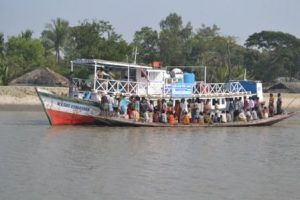
Talking about the mantra towards achieving the set goals, Dr Sandeep Buttan, Global TechnicalLead- Eye Health (Asia), Sightsavers said, “We realised that if a district level impact is desired, an intense pan district program involving all players (eye health and others) is essential. The intensity of our intervention was much higher than elsewhere! There was strong focus on creating lasting behaviour change and generating evidence for impact.” “Every block was targeted for interventions including vision centres in each of them and use of GIS technology for planning and monitoring. Very close follow up of activities and outcomes, every month.”
“It was a wonderful experience of team work with 3 partners along with Sightsavers. It was a cohesive unit and we all worked in a seamless manner,” was the lasting impression shared by Dr Asim Sil.
Optometry Curriculum through ErasmUS is now available online in India
Optometry Curriculum for Lifelong Learning through ErasmUS is now online on the Erasmus+ Project Results Platform.
It is being implemented in India for optometry education through three universities:
-
Chitkara University, Chandigarh: Key Contact: Prof Preethi <preethi@chitkara.edu.in>
-
University Of Hyderabad, Hyderabad: Key Contact: Prof Geeta<gkvemuganti@gmail.com>
-
Manipal University, Manipal: Key Contact: Key Contact: ramesh.sve@manipal.edu
-
ASCO INDIA-Association of Schools and Colleges of Optometry: Key Contact: Prof Aditya Goyal<adityagoyal@hotmail.com>
For details visit: http://bit.ly/2snxSxE

